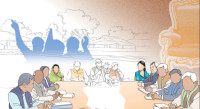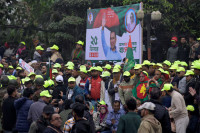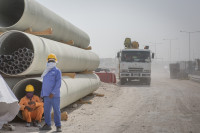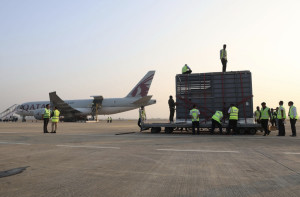Columns
Stagnation amid uncertainty
The budget is expected to hinder business growth and contract demand.
Pradeep Yadav
It seems that a remedy to the current economic stagnation cannot be achieved through fiscal policy alone. There are indications that an immediate solution to the market slowdown in this budget shift is unlikely. It is evident that the 2023-24 budget has pressured the monetary system to attain the objective of 6 percent economic growth by augmenting liquidity flow.
Finance Minister Prakash Saran Mahat has brought a contractionary fiscal policy by imposing tax hikes rather than promoting the middle class through a budget of Rs1.751 trillion. This approach is expected to further hinder business growth and contract demand. Moreover, foreign loans and aid are regarded as primary sources, while reliance on domestic loans has been elevated. As the government's propensity to spend weakens, internal debt is projected to exacerbate the liquidity constraints within the financial system.
Overall, there is an absence of policies aimed at stimulating the market. By exhibiting its reliance on the financial system to bolster the market, the government is likely to introduce further economic distortions. The government has set a target of achieving 6 percent economic growth while seeking flexibility in loan investments. Consequently, the dependence of fiscal policy on monetary policy has intensified.
Although the government has set a target of 8 percent economic growth in the current fiscal year, the Nepal Rastra Bank (NRB) has established a credit expansion target of 12.6 percent. To balance the external sector, the NRB has ceased monetisation in the present year. So economic growth is estimated to remain around 2 percent following the market recession.
For the coming fiscal year, while the government has a growth target of 6 percent, the credit expansion target should be approximately 20 percent. However, considering that the target of around 13 percent has not been met, the ambitious credit expansion target is likely to destabilise the market.
There is nothing exceptional in the budget. Although the budget speech was well received, everything has been constricted due to the tax policy. In such a scenario, the responsibility of revitalising the market has again fallen on monetary policy's shoulders. However, monetary policy also faces certain limitations. It will be interesting to observe how monetary policy addresses these challenges.
The budget was expected to provide a stimulus package for the contracting sector. The National Statistics Office (NSO) itself has reported negative growth in certain sectors. As a result, the market has not experienced a recession as envisioned by the government through the budget. The private sector has begun criticising the budget, with the Federation of Nepalese Commerce and Industry (FNCCI) strongly opposing the tax policy and the Confederation of Nepal Industry (CNI) protesting the absence of programmes aimed at revitalising the sector.
Meanwhile, the central bank has started the preparation of monetary policy for the coming fiscal year to achieve the targets outlined in the budget. Recommendations have begun to be put forth, although they are primarily ceremonial. Monetary policy, as seen in the past, is formulated based on the viewpoints of the governor of the NRB and its top officials.
During recent evaluations, bankers have abstained from offering recommendations. Business individuals contend that unless the NRB demonstrates accountability comparable to that of the government, the market recession will endure for an extended period. Furthermore, the central bank has already provided debt restructuring and rescheduling options on two occasions, making it inadvisable to extend additional time towards enhancing non-performing loans.
The central bank will actively manage liquidity both directly and indirectly. If liquidity is insufficient, it will be injected into the market, while excess liquidity will be mopped up. However, relying solely on monetary instruments for liquidity provision is not sustainable. Public expenditure is crucial for creating a sustainable and viable market, and the government has a strong role in this regard. The central bank’s failure to perceive signs of economic relaxation and recession may lead to a surge in non-performing loans within the financial system, resulting in financial imbalances.
The finance minister has announced measures in the budget to reduce income inequality by implementing a luxury tax for the first time and imposing additional levies on overseas travel. While symbolic, these provisions convey the message that the wealthy should bear a more significant tax burden. The budget lacks catchy slogans and contains fewer programmes directly impacting people's lives. Given the economy's weak state, despite efforts by the construction sector to stimulate economic activity, the budget is perceived as lacklustre with no immediate outcomes anticipated. However, positive results can be expected if the finance minister focuses on its implementation as strictly as he has made budgetary proposals. Although it may seem unexciting presently, the budget is realistic and feasible.
The government is relying on domestic borrowing to cover the budget deficit while the government and the private sector are competing for resources within the financial system. This situation leads to the government absorbing capital that the private sector requires for mobilisation, resulting in a "crowding out effect" where private sector resources become scarce. Furthermore, the country is facing a twin deficit scenario, as the large budget deficit translates into an unfavourable trade deficit. This double loss creates a challenging balance of payments situation for Nepal.
Remittances, private sector credit and government credit appear to be the driving forces of the economy. However, their contribution primarily pertains to resource transfers rather than stimulating production. As a result, the dichotomy between the real sector (productive activities) and the financial sector is widening. Typically, during an economic recession, governments are expected to increase spending. However, it may only apply to some of the current situations in Nepal.




 11.12°C Kathmandu
11.12°C Kathmandu













%20(1).jpg&w=300&height=200)

